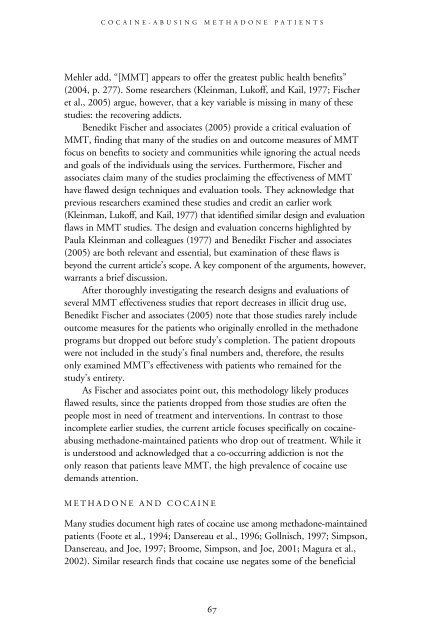2006 - School of Social Service Administration - University of Chicago
2006 - School of Social Service Administration - University of Chicago
2006 - School of Social Service Administration - University of Chicago
You also want an ePaper? Increase the reach of your titles
YUMPU automatically turns print PDFs into web optimized ePapers that Google loves.
COCAINE-ABUSING METHADONE PATIENTS<br />
Mehler add, “[MMT] appears to <strong>of</strong>fer the greatest public health benefits”<br />
(2004, p. 277). Some researchers (Kleinman, Luk<strong>of</strong>f, and Kail, 1977; Fischer<br />
et al., 2005) argue, however, that a key variable is missing in many <strong>of</strong> these<br />
studies: the recovering addicts.<br />
Benedikt Fischer and associates (2005) provide a critical evaluation <strong>of</strong><br />
MMT, finding that many <strong>of</strong> the studies on and outcome measures <strong>of</strong> MMT<br />
focus on benefits to society and communities while ignoring the actual needs<br />
and goals <strong>of</strong> the individuals using the services. Furthermore, Fischer and<br />
associates claim many <strong>of</strong> the studies proclaiming the effectiveness <strong>of</strong> MMT<br />
have flawed design techniques and evaluation tools. They acknowledge that<br />
previous researchers examined these studies and credit an earlier work<br />
(Kleinman, Luk<strong>of</strong>f, and Kail, 1977) that identified similar design and evaluation<br />
flaws in MMT studies. The design and evaluation concerns highlighted by<br />
Paula Kleinman and colleagues (1977) and Benedikt Fischer and associates<br />
(2005) are both relevant and essential, but examination <strong>of</strong> these flaws is<br />
beyond the current article’s scope. A key component <strong>of</strong> the arguments, however,<br />
warrants a brief discussion.<br />
After thoroughly investigating the research designs and evaluations <strong>of</strong><br />
several MMT effectiveness studies that report decreases in illicit drug use,<br />
Benedikt Fischer and associates (2005) note that those studies rarely include<br />
outcome measures for the patients who originally enrolled in the methadone<br />
programs but dropped out before study’s completion. The patient dropouts<br />
were not included in the study’s final numbers and, therefore, the results<br />
only examined MMT’s effectiveness with patients who remained for the<br />
study’s entirety.<br />
As Fischer and associates point out, this methodology likely produces<br />
flawed results, since the patients dropped from those studies are <strong>of</strong>ten the<br />
people most in need <strong>of</strong> treatment and interventions. In contrast to those<br />
incomplete earlier studies, the current article focuses specifically on cocaineabusing<br />
methadone-maintained patients who drop out <strong>of</strong> treatment. While it<br />
is understood and acknowledged that a co-occurring addiction is not the<br />
only reason that patients leave MMT, the high prevalence <strong>of</strong> cocaine use<br />
demands attention.<br />
METHADONE AND COCAINE<br />
Many studies document high rates <strong>of</strong> cocaine use among methadone-maintained<br />
patients (Foote et al., 1994; Dansereau et al., 1996; Gollnisch, 1997; Simpson,<br />
Dansereau, and Joe, 1997; Broome, Simpson, and Joe, 2001; Magura et al.,<br />
2002). Similar research finds that cocaine use negates some <strong>of</strong> the beneficial<br />
67
















